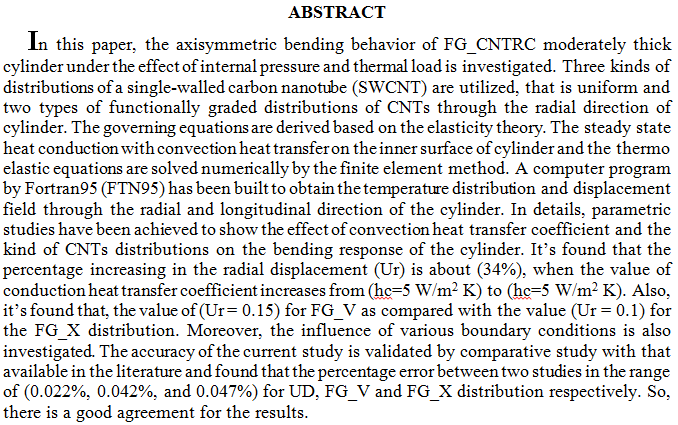
 (15)
(15)
 (5)
(5)
The main aim of this study is to evaluate the remaining oil in previously produced zones, locate the water productive zone and look for any bypassed oil behind casing in not previously perforated intervals. Initial water saturation was calculated from digitized open hole logs using a cut-off value of 10% for irreducible water saturation. The integrated analysis of the thermal capture cross section, Sigma and Carbon/oxygen ratio was conducted and summarized under well shut-in and flowing conditions. The logging pass zone run through sandstone Zubair formation at north Rumaila oil field. The zones where both the Sigma and the C/O analysis show high remaining oil saturation similar to the open hole oil saturation, could be good oil zones that
... Show MoreThe process for preparing activated carbon (AC) made from tea residue was described in this paper. Investigated were the physicochemical characteristics and adsorption efficiency of the produced AC. Activation with potassium hydroxide (KOH) and carbonization at 350 °C are the two key steps in the manufacturing of AC. The activated carbon was used to adsorb Tetracycline (TC). Different parameters were studied at room temperature to show their effects on the adsorption efficiency of TC. These parameters are the initial concentration of adsorbate TC, solution acidity pH, time of adsorption, and adsorbent dosage. The prepared active carbon was characterized using Fourier transform infrared spectroscopy (FTIR), scanning electron microsc
... Show More (1)
(1)
The main aim of this study is to evaluate the remaining oil in previously produced zones, locate the water productive zone and look for any bypassed oil behind casing in not previously perforated intervals. Initial water saturation was calculated from digitized open hole logs using a cut-off value of 10% for irreducible water saturation. The integrated analysis of the thermal capture cross section, Sigma and Carbon/oxygen ratio was conducted and summarized under well shut-in and flowing conditions. The logging pass zone run through sandstone Zubair formation at north Rumaila oil field. The zones where both the Sigma and the C/O analysis show high remaining oil saturation simila
... Show MoreThe process for preparing activated carbon (AC) made from tea residue was described in this paper. Investigated were the physicochemical characteristics and adsorption efficiency of the produced AC. Activation with potassium hydroxide (KOH) and carbonization at 350 °C are the two key steps in the manufacturing of AC. The activated carbon was used to adsorb Tetracycline (TC). Different parameters were studied at room temperature to show their effects on the adsorption efficiency of TC. These parameters are the initial concentration of adsorbate TC, solution acidity pH, time of adsorption, and adsorbent dosage. The prepared active carbon was characterized using Fourier transform infrared spectroscopy (FTIR), scanning electron microscopy (
... Show More (1)
(1)
The aim of this research is to calculate mass transfer coefficient, kd, during cathodic protection of low carbon steel in neutral seawater (3.5% W/V NaCl in distilled water with pH = 7). Two types of cathodic protection were used:
First: Sacrificial anode cathodic protection (SACP) were a pipeline of steel carrying seawater using zinc as a sacrificial anode and with variable temperatures ranged (0 – 45oC) and volumetric flow rate ranged (5 – 900 lit/hr). It was found that the kd increases with increasing temperature and volumetric flow rate of seawater, where kd ranged (0.24×10-6 – 41.6×10-6 m/s).
Second: Impressed current cathodic pr
... Show MoreFunctionalized-multi wall carbon nanotubes (F-MWCNTs) and functionalized-single wall carbon nanotubes (F-SWCNTs) were well enhanced using CoO Nanoparticles. The sensor device consisted of a film of sensitive material (F-MWCNTs/CoONPs) and (F-SWCNTs/CoO NPs) deposited by drop- casting on an n-type porous silicon substrate. The two sensors perform high sensitivity to NO2 gas at room temperatures. The analysis indicated that the (F-MWCNTs/CoONPs) have a better performance than (F-SWCNTs/CoONPs). The F-SWCNTs/CoONPs gas sensor shows high sensitivity (19.1 %) at RT with response time 17 sec, while F-MWCNTs/CoONPs gas sensor show better sensitivity (39 %) at RT with response time 13 sec. The device shows a very reproducible sensor p
... Show More (5)
(5)
The silicon carbide/carbon fiber (SiC/CF) hybrid fillers were introduced to improve the electrical and thermal conductivities of the epoxy resin composites. Results of Fourier transform infrared spectroscopy revealed that the peaks at 3532 and 2850 cm−1 relate to carboxylic acid O–H stretching and aldehyde C–H stretching appearing deeper with an increased volume fraction of SiC. Scanning electron microscopic image shows a better interface bonding between the fiber and the matrix when the volume fraction of SiC particles are increased. As frequency increases from 102 Hz to 106 Hz, dielectric constants decrease slightly. Dissipation factor (tan δ) values keep low a
... Show More (23)
(23)
 (33)
(33)
Investigation of the adsorption of acid fuchsin dye (AFD) on Zeolite 5A is carried out using batch scale experiments according to statistical design. Adsorption isotherms, kinetics and thermodynamics were demonstrated. Results showed that the maximum removal efficiency was using zeolite at a temperature of 93.68751 mg/g. Experimental data was found to fit the Langmuir isotherm and pseudo second order kinetics with maximum removal of about 95%. Thermodynamic analysis showed an endothermic adsorption. Optimization was made for the most affecting operating variables and a model equation for the predicted efficiency was suggested.
